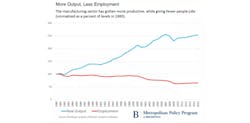What Donald Trump Can Learn From China and Robots When It Comes to Jobs
President-elect Donald Trump may be taking on China's apparent mercantilism via his Twitter account, but both the U.S. and China are embroiled in a dangerous experiment that could crimp their prospects for employment: investment in automation.
Over the past 70 years, China has had the advantage when it came to manufacturing. The cost of labor, in relative terms, was low while policy makers further boosted the competitiveness of the country's export structure through the specialization of production, in a nod to Adam Smith's capitalist treatise "The Wealth of Nations".
But manufacturing jobs in China are massively under threat from automation, a new note from Sanford C. Bernstein & Co., LLC says.
"Mandating a physical task be carried out in a high-cost labor market in 2017 is simply going to increase the chances the task is automated," the analysts, led by Michael Parker, write. "The activity may come 'home,' but there are simply no jobs to steal."
China itself is not only succumbing to this trend — it is actively ramping up investment in robots that threaten to crimp the opportunities for its workers. Parker and his team point out that the country has been spending far more than its peers on robots, so it is now essentially keeping the work but losing the workers. "Walk into H&M or any High Street apparel store anywhere in the world and the clothes that you will find there are all made in Bangladesh, Vietnam or Honduras. China is simply not the factory of the world anymore, or not the low value one," Parker argues, adding that in 2015, China spent 50 percent more on robots than North America and roughly three times more than Japan.
A report from the Brookings Institution last month speaks to many of the same arguments, noting technology is a key contributor for the loss of manufacturing jobs.
"Many are quick to blame trade for a loss of jobs in the manufacturing sector, yet Solís [Foreign Policy Senior Fellow at Brookings] affirms that the predominant force behind losses in manufacturing employment has been technological change (85 percent), not international trade," the report says. "Automation has transformed the American factory, and the advent of new technologies (like robotics and 3D printing) has rendered many low-skilled jobs unnecessary."
The striking chart below shows that in the U.S., greater manufacturing output has not come from more workers.
However, China has had far more rapid growth than the U.S. in recent years, and it's much easier to shift jobs away from manufacturing and into the services sector when your economy is growing at 7 percent per year and starting from a low base. The continued growth, despite the loss of manufacturing jobs, shocked many, Parker adds. "This was supposed to be the end of the Chinese economic experiment," Parker and co. write. "Without factory jobs for the unskilled migrant workers, the engine within the economy was supposed to falter and growth was supposed to collapse. That hasn't happened."
Don't count on that holding true for the U.S. Parker adds that while promising to bring back manufacturing jobs plays well politically, following through on that commitment is a tall order.
"Before the emergence of the General Agreement on Trade and Tariffs and the World Trade Organization, countries could effectively protect domestic industry and jobs through trade barriers," he writes. "Of course, in a world of low-cost and adaptable robots, even the role of the humble trade barrier is up-ended. It is still possible to force the relocation of production through the introduction of tariffs and quotas. However, if the point of the exercise is to restore well-paying, middle class jobs in manufacturing in the process, the result is going to disappoint," he concludes.



